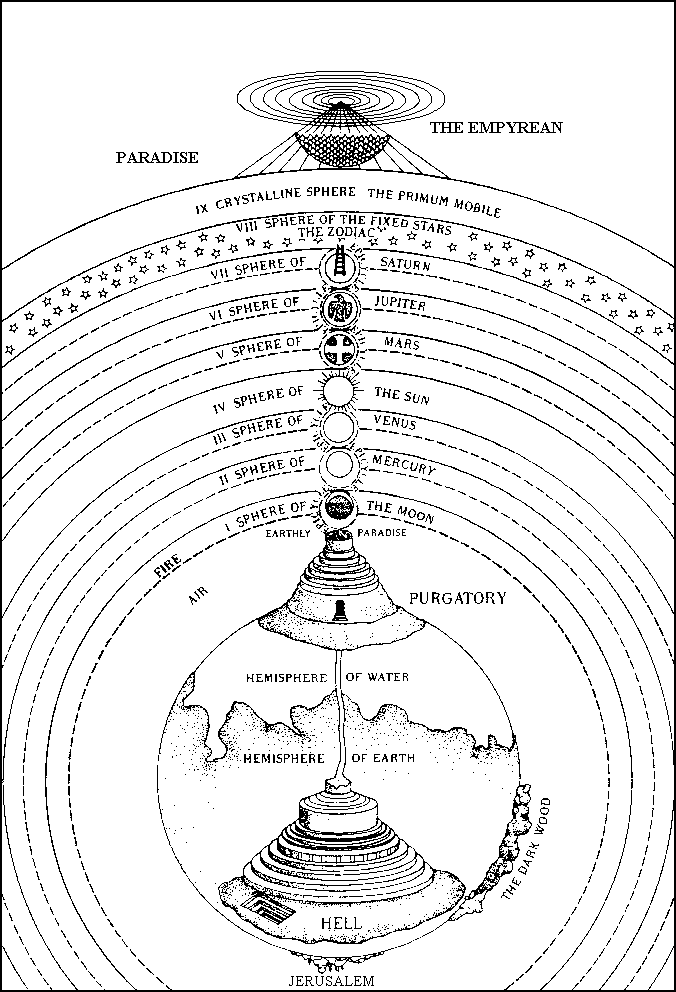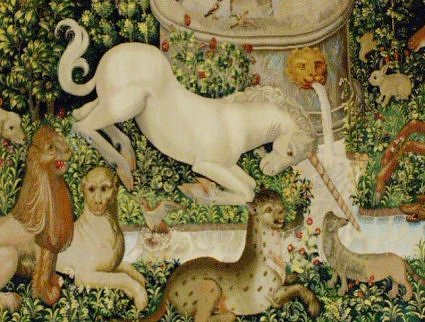The allegorical-religious world view.
- Numerology—see the first full paragraph on p. xxiv of Ciardi's translation.
- Examples from a medieval bestiary. [Cloisters Calendar for 1960: "The text is based largely on the translations by T.H. White of a Cambridge University Library manuscript (II.24.6) in his Book of Beasts"]
The unicorn is a wonderous beast with a single long horn in the center of his forehead. With it the unicorn can wound the great elephant in his belly and thus conquer the largest of animals. He has cloven hooves and can run so fast in the forest that none can catch him. There is one ruse, however, whereby the unicorn can be trapped.
If a virgin girl is led into the woods and seated on a hillock, the unicorn will be attracted to her from afar off. He will come gladly and lay his head in her lap, embracing her and surrendering himself to her. It then that the hunter can come with his spear and kill the unicorn.
For the unicorn's horn is a valuable prize. It absorbs the poison that the serpent spreads on the waters of the forest to kill the animals. In the evening, according to the Greek Physiologus, the unicorn goes to the stream and places his horn in the water, which is thus purified. For this reason the horn is valued among men as proof against poison.
The unicorn is likened to Christ, who also came on earth trhough the graces of a virgin and was betrayed by men. And in St. Luke (1:69) one reads this parallel, "He hath raised up a horn of salvation for us in the house of his son David."
The pelican is a bird that lives near the fastness of the desert beside the Nile River. All the food that the pelican eats it cleanses in the water. When its meal is washed, this strange bird places the food in its mouth with its foot, as if it were a hand.
The pelican loves her children too much. When they grow large in the nest they flap their wings in the faces of their parents and peck at them. In pecking back the mother kills her children. For three days she mourns them. Then with her beak she opens her own breast so that her life blood can flow over the infants. This restores them to life.
The sacrifice of the pelican is similar to that of Christ, who created mankind in his own image and witnessed mankind's evil ways. For this reason he ascended to the cross, where his side was pierced, and the blood and water that flowed from it was for the salvation of mankind.
- Comparison to the modern sense of sense.—What do you say about a rainbow? About an earthquake?
Going along with that, there is a hierarchal world view, which explains everything.
- In the cosmos

- In society
And going along with all of the above, there is the allegorical nature of Dante's poem. Here's something Dante himself said about it:
The subject of the whole work, then, taken merely in the literal sense is "the state of the soul after death straightforwardly affirmed", for the development of the whole work hinges on and about that. But if, indeed, the work is taken allegorically, its subject is: "Man, as by good or ill deserts, in the exercise of his free choice, he becomes liable to rewarding or punishing Justice".
The punishments of sins also usually have a literal and an allegorical meaning. For instance, the punishment of the violent against their neighbors (those guilty of everything from assault to murder) is that they are forced to stand in a river of boiling blood. Literally (& Dante believed it could be true) they are punished as they sinned -- as they made blood flow, they are plunged in blood. Allegorically, the spiritual state of violence is represented by the boiling and the river.


